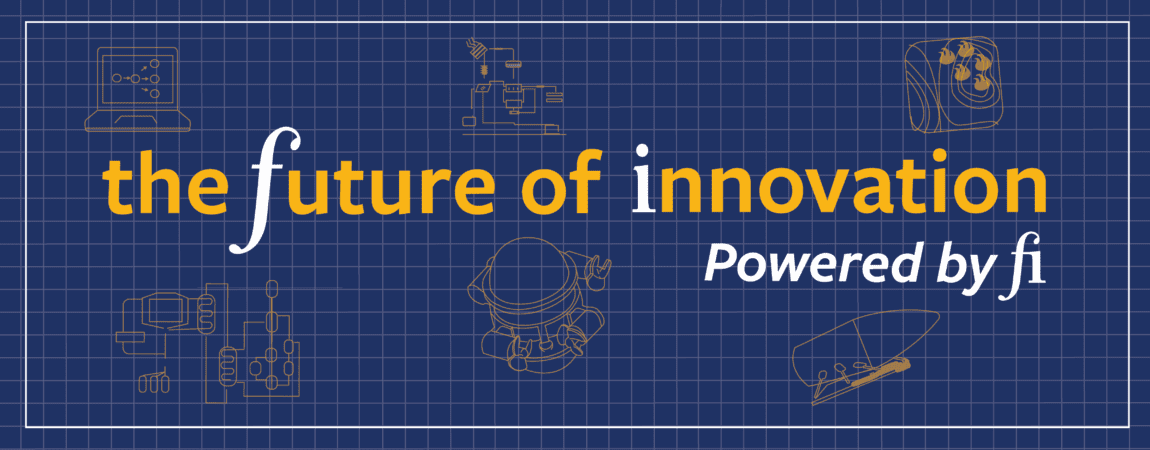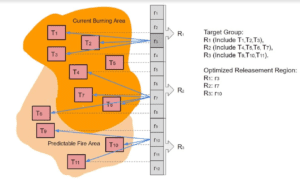May 7 Virtual Capstone Event
The 9th annual UC Berkeley Master of Engineering (MEng) Capstone Showcase took place on Thursday, May 7, 2020 from 5-7pm online. The two-hour event, free and open to the public, featured a selection of MEng teams sharing the results of their year-long capstone projects.
Featured Teams
- Inflatable Modular Solar Array to Meet the Global Energy Demand
- Swarm of Unmanned Underwater Vehicles for Wireless Communication
- Developing an Affordable Alternative for Autonomous Vehicle Localization Using High-Definition Radar Images
- ISAACS: Visualizing Pedestrian Path Prediction for Robot Navigation
- Building Radiation-Detecting Drones Using Scintillating Materials
- Hydrogel to Promote Tissue Regeneration for Volumetric Muscle Loss
- Info Extraction from Clinical Notes Using Natural Language Processing
- Wearable Motion Tracking for Clinical Gait Analysis
- Improving Senior Health Through Gamified VR Exercises
Technical Leadership Capstone Award
- Winner: Smart Eye-Drop Bottle to Monitor Medication Habits of Glaucoma Patients
- Honorable Mention: Biomimetic Hydrogels to Enhance Tissue Modeling of Brain Cancer
- Honorable Mention: Replacing Card Boxes with Smart Reusable Packages
MEng Alumni Award for the Most Innovative Project (Project Brief)
Fung Institute Mission Award
MEng Alumni Award for the Most Innovative Project (Video Pitch)
Honorable Mention: Improving Senior Health Through Gamified VR Exercises
Honorable Mention: Wearable Motion Tracking for Clinical Gait Analysis
10 Tracks, 119 Teams.
Tracks:
- Advanced Manufacturing & New Materials
- Artificial Intelligence, Machine Learning, and Data Science
- Cryptocurrency, Blockchain & Financial Technologies
- Disaster Response: New Tools & Processes
- Energy & Environment
- Health & Well-Being: Data Analytics & Software Applications
- Health & Well-Being: New Tools and Therapies
- Machine Learning: Applications for Entrepreneurship, Strategy, and Operations
- On the Move: Autonomous, Electrical, Areal, Underwater Vehicles
- Visual Computing and Computer Graphics
Advanced Manufacturing & New Materials
Team: Jordan Konick [ME], Faisal Alrakaf [ME], Xuechan Wang [NE], Jiajun Zhai [MSE]
Advisor(s): Peter Hosemann [NE], Matthew Sherburne [MSE]
3D printing has rapidly evolved in recent years, replacing previous prototyping methods and allowing for construction of complex shapes difficult to make via traditional manufacturing methodology. Our team is applying this technology to the nuclear industry, where low production quantity parts and application specific environments provide an ideal application for metal 3D printing. Our team has worked with specialized materials tailored for the extreme environments of nuclear reactors as well as more standard materials to measure the material quality of various samples provided by PolarOnyx’s equipment for this application.
Team: Satomi Angelika Murayama (Fritsch) [ME], Hazelynn Khoo [ME], Meijun Liu [CEE]
Advisor(s): Hayden Taylor [ME]
Today, public schools in tropical countries such as Singapore do not have typical cooling and dehumidification systems, like AC, installed in classrooms. The Berkeley Breathing Facade team is tackling this issue with a new way to cool down the space with minimal energy cost. This semester, we are building a model that can be used to make implementation decisions using Matlab, as well as the team’s expertise in thermodynamics, fluid mechanics and materials science to calculate the levelized cost of comfort.
Team: Srijit Basu [IEOR], Oliver Grueterich [ME], Trevor Rongey [ME], Jeffrey Ward [ME]
Advisor(s): Adam Hansel [Arris], Scott Perkins [Arris], and Matthew Sherburne [MSE]
Products and parts made out of composite materials have great potential for weight and energy savings, but are costly and labor-intensive to produce. Arris Composites is developing a novel method for manufacturing mass-market carbon fiber composites at low cost while making fundamental changes to improve mechanical performance. Our capstone team designed experiments to comprehensively evaluate quality at multiple steps in the manufacturing process and generate data that will support a robust process in the future.
Team: Reef Aldayafleh [BIOE], Jonathan Leban [MSE], Clara Orndorff [ME]
Advisor(s): Dominik Ziegler [Scuba Probe], Hilary Brunner [Scuba Probe], Peter Hosemann [NE]
Scientists are currently limited in exploring nanoscale science due to poor performance of microscopy probes in liquid. Team Scuba Probe is designing a novel microscopy probe with high imaging resolution and an improved lifetime in liquids which will enable further biomedical research. We are developing an encased cantilever probe by performing finite element and failure analyses and optimizing nano-fabrication and characterization techniques to enhance quality. Our project aims to advance probe technology to expand scientific applications and enable scientific advancements.
Team: Cheng-Chun Chao [IEOR], Fangni Zeng [IEOR], Jing Yao [IEOR], Sean Chuang [IEOR], Yasmine Lama [IEOR], Yuanyuan Xiao [IEOR]
Advisor(s): Alex Ackroyd [Lam Research], Gabriel Gomes [ME]
30µm defects on anodized surfaces as large as 0.5m² can cause process failures for semiconductor manufacturers. Early stage defect detection during assembly is thus primordial as it prevents accruing significant losses. Our team leverages computer vision, specifically object detection, to train classification models that accurately and efficiently identify flaws on parts during in-line quality inspections. This solution is easily scalable and can be integrated into the manufacturing line, thereby replacing the current timely manual inspection and eliminating ergonomic harms to operators.
Team: Sorathan (Mike) Munckong [BIOE], Yumeng Xu [MSE], Heting Fu [ME], Alexander Watson [ME]
Advisor(s): Hayden Taylor [ME]
Typical 3D printing takes from 30 minutes up to 7 days or more, depending on the part. Computed axial lithography (CAL), a type of volumetric 3D printing, takes tens of minutes in comparison because it prints the object simultaneously instead of layer by layer. We are testing the boundaries of CAL through algorithm optimization, characterization of multi-material bonding, and integration of green materials which will prove that CAL can overcome constraints presented in existing 3D printing techniques. The result is a greener volumetric printing technology that allows for more versatile printing of 3D objects in a significantly shorter amount of time.
Team: Ning Liu [MSE], Zhinan Leng [MSE], DJ Lindsay [MSE]
Advisor(s): Matthew Sherburne [MSE]
In today’s age of memory industry, companies continually scale down to extend Moore’s Law for smaller, faster, and more energy-efficient RAM devices. Thus, we are investigating HZO and BFO, two materials with robust ferroelectric behavior at nanometer scales in hopes of discovering the fundamental dynamics behind these materials and evaluate their potential to be utilized in advanced electronics. We are fabricating our samples using Pulsed Laser Deposition (PLD) and characterizing them using Piezoresponse Force Microscopy (PFM), Probe Station, and X-Ray Diffraction (XRD).
Team: Alex Wolcott [BIOE], Martin Banet-Rivet [ME], Pablo Amor [ME], Ruobin Liu [ME]
Advisor(s): Boris Rubinsky [ME], Gideon Ukpai [ME]
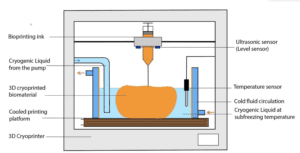 Attempts at 3-D printing biological materials are encumbered by the slow rate of the process and the “soft” nature of the material. Previous successes have invariably yielded objects no larger than a dime, as both the tendency for these materials to collapse and the need to preserve any cells confound the 3-D printing process. We are designing a level-controlled cooling bath to precisely freeze biomaterials as they are printed, thereby addressing both challenges. This new approach allows for far larger printed structures than previously possible.
Attempts at 3-D printing biological materials are encumbered by the slow rate of the process and the “soft” nature of the material. Previous successes have invariably yielded objects no larger than a dime, as both the tendency for these materials to collapse and the need to preserve any cells confound the 3-D printing process. We are designing a level-controlled cooling bath to precisely freeze biomaterials as they are printed, thereby addressing both challenges. This new approach allows for far larger printed structures than previously possible.
Team: Lichen Sun [MSE], Zhihan Hu [MSE], Yun Zhao [MSE], Yang Xiao [MSE]
Advisor(s): Junqiao Wu [MSE]
The $298 billion AR/VR market is in search of a glass material that allows virtual images to be displayed while adjusting incoming light intensity from the real world. The Quick Flash Technologies is offering a low-cost, light-weight, and fast-responding electrochromic glass component for AR glasses. Our product is a glass composite consists of two FTO coated glass layers, two electrochromic layers where the color-changing redox reactions take place, and one electrolyte layer with high ionic and low electronic conductivity.
Artificial Intelligence, Machine Learning, and Data Science
Team: Vyom Kavishwar [EECS], Xing Jin [EECS], Xinran Rui [EECS]
Advisor(s): Kurt Keutzer [EECS], Amir Gholami [EECS], Zhewei Yao [EECS], Michael Mahoney [EECS]
The training time of neural networks is a bottleneck for development in both industryand academia. The training algorithm is intrinsically sequential, which cannot utilize the full computing power of massive parallel architectures. Our team is developing a training methodology based on mathematical principles that achieves better scalability. This training methodology will ultimately result in faster training for all neural network applications.
Team: Pu Xiao [EECS], Yujie Liu [EECS], Joey Lou [EECS]
Advisor(s): Dawn Song [EECS], Peng Gao [EECS]
With abundant data available, industries across the board are taking up the challenge of extracting insights from data. However, with limited expertise in data science, companies often struggle to find efficient use of their data. Our team, together with Professor Dawn Song from Berkeley Artificial Intelligence Research Lab, is currently expanding the functionalities of an inhouse Automatic Machine Learning tool to facilitate data pipeline generation. We aim to help users navigate through the complex data landscape, build insights, and make data science simple for everyone.
Team: Wenxi Xu [EECS], Xiaoya Li [EECS], Hamed Eramian [EECS]
Advisor(s): Dawn Song [EECS], Peng Gao [EECS]
Today’s AI boom has enabled rapid turnaround in scientific discoveries across life science and medical applications. However, traditional machine learning (ML) approaches are time-consuming and challenging due to the manual steps involved. We aim to accelerate scientific discovery by automating traditional ML workflows within two applications: protein design and discovery of yeast biology. Successful automation would require maintaining state-of-the-art performance. Improving performance would be an added bonus. Our approach involves utilizing and understanding the strengths and weaknesses of various automated machine learning (AutoML) frameworks. If successful, we would demonstrate that robust acceleration of scientific discoveries is feasible across various cutting-edge applications.
Team: Yifan Bai [EECS], Sarvagya Singh [EECS], Naijing Zhang [EECS]
Advisor(s): Michael Mahoney [Statistics], Amir Gholami [EECS], Tianjun Zhang [EECS], Zhewei Yao [Math], Zixi Hu [Math]
Simply increasing the time-steps of an ODE (Ordinary Differential Equations) degrades the performance of the neural network while increasing the inference latency. Through our analysis, we show that customizing the time-step for individual layers of the neural network using adaptive time-stepping scheme gives a better performance on image classification task on CIFAR10 dataset. We provide evidence that adaptive time-stepping does not simply learn a suitable time-step configuration for a specific neural network architecture or application, but contributes towards convergence of the neural network to a better solution. Our proposed solution can benefit IoT edge devices with memory-bound architecture for deep learning applications as it gives better performance with higher compute-to-memory-access ratio.
Team: Bo Li [EECS], Ishaan Malhi [EECS], Kailun Wan [EECS]
Advisor(s): Laurent El Ghaoui [EECS]
Current neural network models are vulnerable to perturbed data. This data can generate unexpected results in prediction and classification tasks. We seek to learn how common adversarial attacks influence the robustness of the novel Implicit Deep Learning Model. Our method is to convert different machine learning models into an Implicit Model and perform attacking algorithms to evaluate its robustness.
Team: Thomas Chen [EECS], Alex Guo [EECS], Kevin Yu [EECS]
Advisor(s): Vladimir Stojanovic [EECS]
The design of analog integrated circuits is traditionally time-consuming due to the large amount of manual labor involved. It becomes worse when the design has to be iterated to arrive at the best solution. Berkeley Analog Generator (BAG) helps alleviate this burden by providing a Python interface between designers and the design tool. Recently, designing high-speed optical link has become of interest, as the need for higher volume of computation keeps increases. The larger volume of computation means faster communication between chips is needed. Our project aims to leverage BAG to design optical receivers fast, given a certain specification.
Team: Janelle Lines [EECS], Francisco Utrera [EECS], Evan Kravitz [EECS]
Advisor(s): Michael Mahoney [EECS], Benjamin Erichson [EECS]
Training a neural network from scratch can be prohibitively expensive given the amount of computational power that it takes to train certain architectures and datasets. In some cases, parallel computing is needed to reduce the training time for particular datasets to the order of weeks. Our team is applying transfer learning to pre-trained robust neural networks. Robust neural networks are different because they’re insensitive to small perturbations in the input image. This method not only significantly speeds up the training process, but also increases classification accuracy by leveraging the network’s pre-trained experience on a separate dataset.
Team: Chuyao Cheng [EECS], Raj Borra [EECS], Dongyu Wang [EECS]
Advisor(s): Vladimir Stojanovic [EECS]
With machine learning (ML) models growing in complexity and size, demand for computational power and efficiency increases. Small devices like phones with ML applications need to be faster for better usability. We are building a framework that can create customizable circuit accelerators that will help speed up the ML application; on the software side, efficient code will be written to map the ML model onto our hardware accelerators. Using state-of-the-art hardware design language to generate these designs, we will co-design the software and the hardware for a particular ML application, creating more efficient solutions for ML applications on small devices.
Team: Yunfeng Gao [EECS], Garey Fleeman [EECS], Alejandro Saldarriaga-Fuertes [EECS], Aman Lunia [EECS], Xinyuan Tu [EECS], Meng Xia [EECS], Milo Webster [EECS], Yulin Zhu [EECS]
Advisor(s): Anant Sahai [EECS], Joshua Sanz [EECS], Vignesh Subramanian [EECS]
By 2025 there will be nearly 40 billion connected devices. As the number of internet-connected devices increases, so does interference between them, limiting their throughput. Because current wireless communication between agents is rigid, and requires a pre-established protocol, devices can’t easily work together to reduce this interference. Our team is using machine learning to teach devices how to discover a protocol optimized for their unique environment. In this way, they can learn to communicate with each other more efficiently.
Team: Zhangcheng Zheng [EECS], Hanbing Zhan [EECS], Eric Tan [EECS], Tianmu Lei [EECS]
Advisor(s): Kurt Keutzer [EECS]
Neural networks are becoming more computationally expensive, but there is a rising demand to run them efficiently on resource-constrained hardware for applications such as autonomous driving. We aim to implement a compression technique (quantization) that reduces the size and inference time of a neural network on different types of hardware. To achieve overall network speedup, our solution uses hardware-aware mixed-precision quantization to assign lower bit precisions to layers that show speedup with little accuracy drop after quantization while keeping higher precisions for layers that are more sensitive to accuracy drops after quantization.
Team: Ujjwal Singhania [EECS], Yijiu Zhong [EECS], Pranay Pasula [EECS]
Advisor(s): Dawn Song [EECS], Ruoxi Jia [EECS]
Artificial videos are becoming indistinguishable from real content. For example, videos of world leaders have been manipulated to make them appear to say incendiary things. Previous approaches have failed to generalize over varied deepfake generation methods. We use machine learning and computer vision to create a classifier that detects deepfake videos and is robust to unseen manipulation methods.
Team: Zhekun Luo [EECS], Jiaxin Cheng [EECS], Qiqin Zhao [EECS], Zeyu Liu [EECS]
Advisor(s): Gerald Friedland [EECS]
Our project aims to build a comprehensive toolkit to help machine learning developers to debug their models. Its functionality includes data/model capacity estimation, dataset resampling, adversarial training, and the generation of warnings/flags/error messages that provide additional metrics for users to tune their models. The toolkit will accelerate the debugging and training process, and can potentially boost the performance of neural network models.
Cryptocurrency, Blockchain & Financial Technologies
Team: Aakash Grover [IEOR], Anqi Shi [IEOR], Adam Moutonnet [IEOR], Yida Cui [IEOR], Zefan Yang [IEOR]
Advisor(s): Xin Guo [IEOR], Wenpin Tang [IEOR]
Traditional machine learning techniques have proven ineffective in an ever-changing environment like financial markets, due to their over-reliance on historical data. We aim to overcome the issue, using a reinforcement learning paradigm to simulate a virtual stock market, comprising of automated bots that compete with each other and learn optimal trading strategies over time.
Team: Philippe Ferreira De Sousa [IEOR], Weichao Chen [IEOR], Yuqi Fan [IEOR], Xianglong Pan [IEOR], Alejandro Molina Sanchez [IEOR]
Advisor(s): Xin Guo [IEOR]
Generative adversarial networks (GAN) is a class of machine learning systems that is made up of two networks that compete against each other during the training phase. Although applications of GANs have increased rapidly, its use in Finance is only at its infancy. Our team will be exploring the application potentials of GANs in Finance as the Capstone project.
Team: Chengyang Ge [IEOR], Mingyang Lou [IEOR], Xintong Jiang [IEOR], Yichen Shen [IEOR], Youssef Lazrak [IEOR], Mingyu Hou [IEOR]
Advisor(s): Xin Guo [IEOR], Wenpin Tang [IEOR]
We aspire to develop a Machine Learning algorithm to make optimal trading strategies and increase financial profits.
Team: Alex Chen [IEOR], Yue Hu [IEOR], Chien-Hsun Huang [IEOR], Yao-Chieh Hu [IEOR], Ming Yu Chi [IEOR], Nicolas Kardous [IEOR]
Advisor(s): Xin Guo [IEOR], Wenpin Tang [IEOR]
This paper strikes the balance in between of the sacrifices by devising a GANs machine learning model on the order book to closely simulate the expected reaction of the book when particular executions and decisions have been made. The model will capture both the direction and the degree of the responses of the market given its comprehensive reproduction of the financial body. Upon the research, auto-trading bot and algorithm would be enabled to analyze their effectiveness on an imitated field for low-cost improvements.
Team: Jin Fang [IEOR], Michael Karpe [IEOR], Zhongyao Ma [IEOR], Chen Wang [IEOR], Jacques Olivier Weulassagou [IEOR], Yiyaqi Zuo [IEOR]
Advisor(s): Xin Guo [IEOR], Wenping Tang [IEOR], Haoyang Cao [IEOR], Yusuke Kikuchi [IEOR]
This project applies multi-agent reinforcement learning (RL) theory to optimize the execution strategy in limit order book (LOB) trading. First, we simulate financial trading environment not only with historical data, but also with trading agent interaction in the market, to make the simulation more accurate. We train agents to capture LOB micro-structure behaviors with respect to market realism. Next, we construct RL framework to train a robust policy for LOB execution. We aim to apply model-free RL algorithm, to minimize the overall trading cost within the simulated market environment.
Team: Huiling Chen [IEOR], Charles (Wang) He [IEOR], Yecheng Liu [IEOR], Abdollah Rida [IEOR], Yuyang Shao [IEOR], Xinyu Wang [IEOR]
Advisor(s): Xin Guo [IEOR], Haoyang Cao [IEOR], Wenpin Tang [IEOR], Yusuke Kikuchi [IEOR]
The Credit Default Swap (CDS) market is under regulation and there’s no obligation for buyers and sellers to report transactions. Therefore, the current CDS index transaction record is limited and hard to work with. If one owns a valid and high-quality set of CDS index records, the institution may have advantages over its competitors since CDS indices trade volume increased steadily over the past few years. We are generating synthetic CDS trade data similar to the existing record using Generative Neural Network (GANs) which includes a generator and a discriminator. To validate the synthetic dataset, we are using other machine learning models and techniques and the result shows that we achieve over 90% similarity between the real and synthetic data.
Team: Francesco Piccoli [IEOR], Salomé Schwarz [CEE], Ravi Bhandia [IEOR], Elaine (Yuyang) Zhao [IEOR]
Advisor(s): Doug Purdy [xPring / Ripple], Paul Grigas [IEOR]
In the last decade, the use of cryptocurrencies has revolutionized the process of exchanging and transferring money to all corners of the world. The use of cryptocurrencies faces vulnerabilities, however. Sometimes coordinated attacks from hackers or big financial players can undermine the stability of those crypto networks. Our objective is to identify these anomalies on the XRP ledger and promptly notify Ripple’s community.
Team: Charles Garnot [CEE], Fuhua Liu [IEOR], Yijun Liang [IEOR]
Advisor(s): Doug Purdy [xPring / Ripple], Paul Grigas [IEOR]
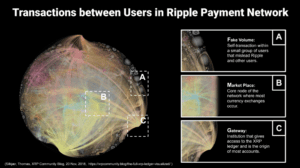 Since 2017, the beginning of speculation over cryptocurrencies, price volatility has become a barrier for daily use of cryptocurrencies, including Ripple’s XRP. In order to enhance adoption of XRP as a medium of exchange, a technical requirement is to catch and prevent behaviors that may cause unstable prices. Our team is creating a detection system to identify abnormal activities using machine learning models. We analyze unexpected events in transaction volume, fee increases, and account creation. A Slackbot will report our analysis and send timely alerts to Ripple’s engineers so they can take measures that will improve confidence in XRP value.
Since 2017, the beginning of speculation over cryptocurrencies, price volatility has become a barrier for daily use of cryptocurrencies, including Ripple’s XRP. In order to enhance adoption of XRP as a medium of exchange, a technical requirement is to catch and prevent behaviors that may cause unstable prices. Our team is creating a detection system to identify abnormal activities using machine learning models. We analyze unexpected events in transaction volume, fee increases, and account creation. A Slackbot will report our analysis and send timely alerts to Ripple’s engineers so they can take measures that will improve confidence in XRP value.
Team: Peijie Li [IEOR], Moraldeep Sachdeo [IEOR], Huidi Wang [IEOR], Lance Zeng [IEOR]
Advisor(s): Kevin Feng [Beam], Tennison Yu [Beam], Liying Li [Beam], Anil Aswani [IEOR]
Approximately $300 billion (1.5% of GDP) is laundered annually through the United States, most of it connected to fraud. While financial institutions have strong security measures and regulations to combat fraud, online platforms that enable financial transactions have become a new source of illicit financial activities. Due to the unregulated nature of this emerging industry, tracking and identifying financial fraud is difficult. The Beam team is building machine learning models to preemptively flag suspicious activity so enforcement officers can take action with confidence. Our team’s models will detect suspicious financial transactions, using cutting-edge natural language processing techniques to identify anomalous groups of text messages associated with transactions.
Team: Changze Cui [EECS], Mingcheng Zhu [EECS], Muliang Shou [EECS], Timothy Delille [EECS]
Advisor(s): Dawn Song [EECS]
There are many security and privacy vulnerabilities found in modern blockchain applications. Cryptocurrency trading is not as secure as you think. Decentralized cryptocurrency exchanges are vulnerable to certain exploitations like front running attacks. Machine learning can violate data privacy. Tech giants do not want to share their data but still want to benefit from each other. Some blockchain consensus suffers from insecure leader selection. PBFT, a common consensus algorithm, is vulnerable to attack related to the leader selection procedure. Therefore, our team is working on developing algorithms and systems to address those issues. Specifically, we use federated machine learning, Kyber Network’s architecture, and Snowball protocol to build an on-chain machine learning system, a front running-resistant decentralized exchange, and a PBFT-based leaderless consensus algorithm. The results will make those blockchain applications more secure and efficient.
Disaster Response: New Tools & Processes
Team: Jamie Chen [ME], Sonny Li [ME], David Tondreau [ME], Mengyue Wang [ME]
Advisor(s): Koushil Sreenath [ME]
Disaster relief demands both speed and adaptability to complex terrain; however, modern robots, which offer the potential to aid first responders, are currently specialized either for speed (wheeled robots) or for adaptability (legged robots). Our team is working to enable the transition of bipedal robots between legged locomotion and wheeled transportation. Our approach is to develop a full-stack autonomous system with perception to recognize the hovershoe, trajectory optimization for precise foot placement, and a series of inner controllers to realize the trajectory.
Team: Annie Chen [ME], Weiyang Qin [ME], Lixin Zhao [ME], Chih Yi Lin [ME]
Advisor(s): Gabriel Gomes [ME]
Trajectory planning is an essential component in the controls of autonomous wheeled robots. In contrast to more traditional approaches based on control theory, this project focuses on a new approach for solving the problem of optimizing trajectory in environments with static and dynamic obstacles. Our team is implementing reinforcement learning techniques to train unsupervised wheeled robots to generate a collision-free path in a simulated site with obstacles and to locate a target in an unknown position. The algorithm is effective for navigation scenarios and scalable for real-world applications, such as training robots that provide assistance to people at disaster sites.
Team: Eliana Abbas [ME], Abhishek Bhagwat [ME], Shawn Marshall-Spitzbart [ME], Rebecca Schwartz [ME], Aditya Vipin Thomas [ME]
Advisor(s): Douglas Hutchings [Squishy Robotics], Alice M. Agogino [ME]
Mobile tensegrity robots have the potential to revolutionize the field of emergency response by gathering immediate data via visual & chemical sensors. Their tensegrity structure enables movement through various terrains- enabling the robots to assist emergency responders, such as fire departments and the military, in assessing hazardous situations. Our specific project has two core goals: to improve the accuracy & functionality of the present mobile robot’s electronics, and to test the feasibility of a mobile robot whose actuation is controlled via the central payload. These improvements will facilitate proper robot locomotion and decrease the complexity required to operate the mobile robot. The tools we are using include rapid prototyping, control simulation, and sensor calibration. We hope to accomplish continuous motion for the centrally actuated prototype, and optimal control based on current sensing results for the present mobile robot design.
Team: Wei Huang [MSE], Rui Sun [CEE], Rui Xu [ME], Jingtong Zhao [MSE]
Advisor(s): Tarek I. Zohdi [ME]
Applying drones to monitor on-going wildfires is a novel method to help firefighters put out fires and facilitate evacuation. Due to the limitation of drones’ electrical or fossil energy, it is necessary to plan the shortest paths for a drone swarm to deploy them efficiently.To reach the goal, machine-learning-based path planning algorithms are created to reduce the energy consumed on path as much as possible. Related high-risk wildfire location forecasts, fire propagation predictions, and drones’ computer vision scanning process are also investigated to improve drone deployment effectiveness.
Team: Kunj Jain [ME], Varun Save [ME], Jigisha Sampat [ME], Wai Nyein [ME], Mruthun Thirumalaisamy [ME], Anita Zhao [ME]
Advisor(s): Douglas Hutchings [Squishy Robotics], Alice Agogino [ME], Brian Cera [ME]
When a disaster strikes, any information on ground-zero becomes extremely crucial for effective and efficient emergency response. Currently, first responders enter disaster zones not knowing what to expect. We at Squishy Robotics design and build rapidly deploy-able sensing robots which can transmit real time information about the environment to save lives. We accomplish this by refining the robot hardware and software to improve the drop-performance, survival and drop targeting accuracy. Lastly, we are streamlining the human-robot interaction.
Team: Jeremiah Hamlin [ME], Mikio LaCapra [ME], Carlos Nunez [IEOR]
Advisor(s): Tarek I. Zohdi [ME]
Wildfires have become an annual destructive force with the 2018 California wildfires witnessing the tragic loss of life and $3.5 billion in damages, which unraveled communities and motivated new outlooks to safety and liability. Our solution harnesses the novel firefighting technique of real time low computation wildfire prediction simulations, through a particle based representation of ember lofting dynamics and thermodynamics over real terrains. Not only does this simulation predict fire trajectory patterns to prevent hazardous scenarios, it can be paired with historical data for economical risk management such as assisting insurance companies establish rates based on the burn risk of a property.
Team: Xiaohan Gong [IEOR], Casey Zhou [IEOR], Emilien Etchevers [IEOR]
Advisor(s): Mayur Mudigonda [terrafuse.ai], Jing Li [terrafuse.ai], Adrian Albert [terrafuse.ai], Brian White [terrafuse.ai], Daniel Feldman [LBL], Tarek Zohdi [ME]
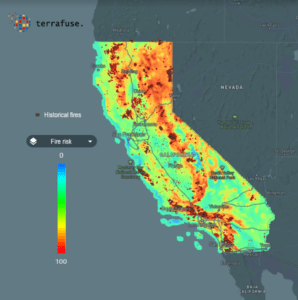 In 2018, over 7579 wildfires have burned more than 1,667,855 acres of land area in California alone. Our team is developing a prediction tool to estimate and showcase wildfire ignition risks on a weekly-basis state-wide, for continuous monitoring. Through the use of computer vision algorithms based on regularly updated historical satellite data, we will create a risk index which can then be used by insurance providers, government agencies and individuals alike.
In 2018, over 7579 wildfires have burned more than 1,667,855 acres of land area in California alone. Our team is developing a prediction tool to estimate and showcase wildfire ignition risks on a weekly-basis state-wide, for continuous monitoring. Through the use of computer vision algorithms based on regularly updated historical satellite data, we will create a risk index which can then be used by insurance providers, government agencies and individuals alike.
Energy & Environment
Team: Jules Bertrand [IEOR] Ramdane Bessaïd [CEE] Dyami Andrews [ME]
Advisor(s): Byron Pakter [Optony] Gabriel Gomes [ME]
Climate-related policies are becoming increasingly important for local governments, especially in California since the Global Warming Solutions Act of 2006. Cities face several issues in tracking these policies, such as obtaining clean and consistent data or automating data retrieval. Our project aims to standardize the monitoring of local climate policies (renewable energy, building insulation, …) by analyzing data collected 1.via cities 2.via various web sources. Our platform will be automatically updated and data will be presented in a decision-ready and easy-to-use manner. It will allow cities to quickly know the impact of their policies, correct them and thus spend their money more efficiently.
Team: Zishen Chen [ME], Remi Le Thai [ME], Cindy Li [IEOR]
Advisor(s): Reza Alam [ME], Michael Kelly [ME]
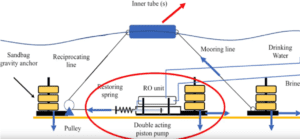 The cost for seawater desalination has decreased from $0.0095/gallon in 1972 to less than $0.0025/gallon and concentrated from capital expenditure to electricity cost. However, due to electricity shortage in emergency situation, it’s difficult to produce affordable drinking water for coastal communities. To support them, we are designing a sustainable and compact wave-powered desalination system that produces 105 gallons drinkable water per day at competitive cost. Provided a daily benchmark of 3 gallons fresh water per person, this device can support community with 35 people. Our solution relies on a reverse osmosis unit powered by ocean waves, mainly composed of inflatable materials to reduce both size and cost, and a robust mooring system that ensures survivability.
The cost for seawater desalination has decreased from $0.0095/gallon in 1972 to less than $0.0025/gallon and concentrated from capital expenditure to electricity cost. However, due to electricity shortage in emergency situation, it’s difficult to produce affordable drinking water for coastal communities. To support them, we are designing a sustainable and compact wave-powered desalination system that produces 105 gallons drinkable water per day at competitive cost. Provided a daily benchmark of 3 gallons fresh water per person, this device can support community with 35 people. Our solution relies on a reverse osmosis unit powered by ocean waves, mainly composed of inflatable materials to reduce both size and cost, and a robust mooring system that ensures survivability.
Team: Kaiyu Chen [EECS], Wei-Hsuan Hsu [EECS], Yuxin Zhao [EECS], Chuan-Jiun Yang [EECS]
Advisor(s): Alberto L. Sangiovanni-Vincentelli [EECS], Alessio Iovine [EECS]
Managing the hybrid energy storage system (HESS) on a large scale is a challenging task. Our team is dedicated to developing a tool capable of modeling and describing the possible energy market participation using storage devices. The tool takes into account the limitations (e.g. capacity, aging) of multiple kinds of storage devices, such as batteries, flywheels. It also applies multiple-objective optimization techniques to find optimal market actions based on historical data. Our delivery is a robust, scalable energy dispatch algorithm that can select the best bidding strategy to maximize the profits participating in the energy market.
Team: Gina Myers [BIOE], Arthur Labarre [CEE], Weiheng (Jarvis) Lu [IEOR], Priyaj Mehta [ME], Ronggen Chen [ME]
Advisor(s): Tarek Zohdi [ME]
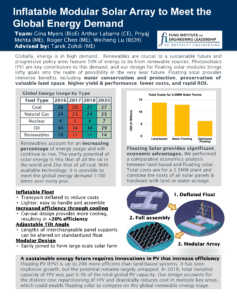 Improved photovoltaic technology is essential to meet growing global energy demands. Floating solar offers numerous advantages over land-based, including increased efficiency via cooling, reduced evaporation and algal growth, and the financial and ecological benefits of facile installation and protecting undeveloped land. Our diverse team created a floating solar module for inland water bodies that is more energy and cost-efficient and easier to install than existing technologies. To accomplish this, our design incorporates an on-site inflatable floating structure, onto which the photovoltaic panels are mounted. This is a transformative innovation as it enables drastically lower transportation and installation costs.
Improved photovoltaic technology is essential to meet growing global energy demands. Floating solar offers numerous advantages over land-based, including increased efficiency via cooling, reduced evaporation and algal growth, and the financial and ecological benefits of facile installation and protecting undeveloped land. Our diverse team created a floating solar module for inland water bodies that is more energy and cost-efficient and easier to install than existing technologies. To accomplish this, our design incorporates an on-site inflatable floating structure, onto which the photovoltaic panels are mounted. This is a transformative innovation as it enables drastically lower transportation and installation costs.
Team: Yee Jiunn Terh [NE], Christian Sclafani [NE]
Advisor(s): Raluca Scarlat [NE]
Nuclear power plants using molten salt coolant and liquid fuel, with lower operating pressure and better fuel utilization, are safer and more sustainable than conventional reactors. However, the behaviors of the molten salts have not yet been fully characterized. This project is part of the Molten Salt Working Group initiative, in association with Oak Ridge National Laboratory, and will focus on developing characterization procedures using Factsage computational software to optimize liquid nuclear fuel compositions for the next generation of nuclear reactors.
Team: Luis Fernández [ME], Matthew James [ME], Agustín Toll-Villagra [IEOR]
Advisor(s): Byron Pakter [Optony Inc.], Gabriel Gomes [ME]
About 4 billion people, more than half the world’s population, experience severe water scarcity for at least one month a year. Desalination can improve the lives of many of these people, but it typically comes at a high environmental and economic cost. Our web-based application helps any interested party quickly evaluate the economic feasibility of building a desalination system that uses renewable energy and does not pollute waterways with toxic brine discharge. Using a mathematical model we developed, our tool would give the end-user a high-level physical design of the plant along with estimated financial reports using just a few key parameters that constrain the plant’s design.
Team: Nouf Alfayez [MSE], James Bramble [NE], Junrong Li [NE], Chai Peddeti [NE], Zhihao Qin [NE], Christopher Reis [NE]
Advisor(s): Peter Hosemann [NE]
As we work closer toward achieving breakeven fusion power in magnetically confined plasma architectures, it is of significance we understand the functionality of superconducting magnets that will be bombarded by the 14.1 MeV neutrons emitted. The same technology is applicable to a wide range of accelerators and beams.
Health & Well-Being: Data Analytics & Software Applications
Analyzing the Impact of Clinicians’ Behavior on Patients’ Diabetes Management Using Machine Learning
Team: Henrieke Baunack [IEOR], Renuka Shahane [BIOE], Scott Guidoboni [BIOE], Yuchen (Ada) Che [IEOR]
Advisor(s): Sarine Babikian [Glooko], Vikram Singh [Glooko], Anil Aswani [IEOR]
1 out of 7 people in the United States have diabetes and 80 thousand die each year as a result. Doctors’ recommendations during an appointment can substantially impact the patient’s diabetes management. Our team, in collaboration with Glooko, a startup in the digital diabetes management business, is evaluating the correlation between the usage of the Glooko web application during an appointment and the patient’s diabetes management. Using Machine Learning algorithms, we are working on improving Glooko’s recommendations and training protocols for doctors regarding their web app usage.
Team: Yisheng Chen [BIOE], Zihang Shao [BIOE], Hanxiao Zhang [BIOE]
Advisor(s): J. Christopher Anderson [BIOE]
Our project is to build a software that takes over the design work for molecular cloning from human researchers and provides valid sequence as required fast and efficiently.
Team: Connor Anderson [BIOE], Bryan Cai [BIOE], Lauren Enriquez [BIOE]
Advisor(s): J. Christopher Anderson [BIOE]
Predicting enzymatic activity is a powerful tool for effectively synthesizing and characterizing novel compounds. Current enzyme prediction algorithms infer enzyme preferences by analyzing enzyme-compatible molecules (positive substrates). However, these algorithms neglect enzyme-incompatible molecules (negative substrates). Our software, CAERS, analyzes the structure-activity relationships (SAR) of positive and negative substrates to generate an ensemble that illustrates all of an enzyme’s specificity preferences. This new approach allows CAERS to evaluate novel substrates and predict their enzyme compatibility. The result is a biologically accurate reaction prediction software. CAERS expedites compound synthesis and characterization research by generating the most biologically favorable compounds to further investigate.
Team: Jiali Chen [EECS], Jude Fernandes [EECS], Nicolas Swenson [EECS]
Advisor(s): Kathy Yelick [EECS], Aydin Buluc [EECS], Andrew Tritt [Berkeley Lab]
There are millions of proteins with unknown functions. To aid scientists in further decoding the protein universe, we are building a state-of-the-art machine learning tool. Using novel language models and graph neural networks to embed the protein universe, we can bring unprecedented success in functional annotation of proteins.
Team: Gary Yu [IEOR], Melvin Ang Kai Lun [IEOR], Mihir Rajhansa [BIOE], Wenxi Li [IEOR], Yangyi Li [IEOR]
Advisor(s): Scott Lee [UC Berkeley School of Public Health], Tarek Zohdi [ME]
Over $60 billion ($1000 per Medicare member) is lost to fraud and improper payments each year and CMS auditors cannot handle the volume of cases. Our machine learning model detects high risk doctors and prioritizes them for audits. The vision is to partner with CMS (Medicare) so they can use our program to shortlist doctors to investigate. We use combination of expert knowledge, statistics, and machine learning techniques such as clustering and outlier detection to identify high risk doctors from publicly available dataset provided by CMS.
Team: Lengning Wei [BIOE], Marcel Schaack [BIOE], Chloe Kim [BIOE]
Advisor(s): Gundolf Schenk [UCSF], Gabriel Gomes [ME]
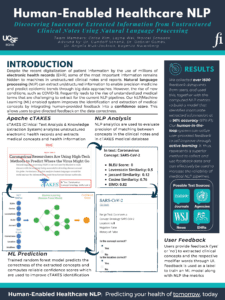 Despite the development of medical records systems, there is no precise technology for large-scale information extraction, public health research and precision medicine. We designed a reliable NLP-enabled system that extracts the medical history from health records and provides users with the ability to give targeted user-input on NLP-correctness, creating an active-learning feedback loop that allows the system to continuously improve. We trained a machine learning model with user input and incorporated NLP metrics to provide confidence scores to users, enabling them to evaluate the accuracy of extracted information from cTAKES, the most commonly used system for large-scale clinical data analysis.
Despite the development of medical records systems, there is no precise technology for large-scale information extraction, public health research and precision medicine. We designed a reliable NLP-enabled system that extracts the medical history from health records and provides users with the ability to give targeted user-input on NLP-correctness, creating an active-learning feedback loop that allows the system to continuously improve. We trained a machine learning model with user input and incorporated NLP metrics to provide confidence scores to users, enabling them to evaluate the accuracy of extracted information from cTAKES, the most commonly used system for large-scale clinical data analysis.
Team: Aparna Mohan [IEOR], Vivian Fu [BIOE], Yiyi Chen [IEOR], Zezhi Zhang [IEOR]
Advisor(s): Anil Aswani [IEOR]
Chronic diseases can sometimes remain undiagnosed in the early stages and affects a large population in the United States. Increasing treatment costs demand the need to bring healthcare assessment into the home setting by ensuring early prediction to assess if a person has a high likelihood of developing diabetes or depression. Our team solves this issue by using data from NHANES to build machine learning classification models such as Random Forest, Logistic Regression, k-nearest neighbours, providing accurate and quick predictions. The established model will be presented through a web page providing users a prediction for the likelihood of developing diabetes and depression.
Team: Hanmi Zou [IEOR], Lemin Kong [IEOR], Jungwon Kim [BIOE]
Advisor(s): Raouf Muhamedrahimov [Zebra Medical Vision], Anil Aswani [IEOR]
 The goal of this project is to develop an algorithm to quickly identify and visualize abdominal diseases in CT scans to prioritize public health resources. The use of Machine learning in medical imaging will save healthcare organizations’ time and money while improving patient care efficiently. Intended applications of this algorithm will make CT scan assessment four times faster and provide an early alert to radiologists so that patients with suspected acute conditions can be prioritized.
The goal of this project is to develop an algorithm to quickly identify and visualize abdominal diseases in CT scans to prioritize public health resources. The use of Machine learning in medical imaging will save healthcare organizations’ time and money while improving patient care efficiently. Intended applications of this algorithm will make CT scan assessment four times faster and provide an early alert to radiologists so that patients with suspected acute conditions can be prioritized.
Health & Well-Being: New Tools and Therapies
Team: Isha Sharma [BIOE], Shengyu Xu [BIOE]
Advisor(s): Syed Hossainy [BIOE]
Osteoarthritis (OA) is a common degenerative joint disease caused by progressive loss of articular cartilage. The Centers for Disease Control and Prevention indicates that more than 30 million adults in the USA suffer from OA. We are developing a novel polymeric formulation that drives regeneration of damaged knee cartilage through cartilogenesis. We intend to treat OA using an electro-active polymer, which can be injected into the joint space of an affected knee and controlled by external electro-magnetic field to induce cellular regeneration. This offers a (i) minimally-invasive and (ii) time-saving alternative to the existing invasive knee-replacement surgery.
Team: Charit Mehta [ME], Aishwarya Pamula [BIOE], Sheila Sharifzad [BIOE]
Advisor(s): Ying Han [UCSF], Syed Hossainy [BIOE], Dorian Liepmann [ME]
 Affecting over 65 million people worldwide, glaucoma is a disease that creates excessive fluid pressure in the eye and eventually leads to blindness. Severe cases require surgical intervention to redirect fluid to an implant placed on the back of the eye. However, commercially available implants cost up to $1,000 each and have a 50% failure rate within a few years. The I-OPeners Team is developing a low cost, patient-specific glaucoma implant that regulates pressure for a longer duration. Our solution utilizes biocompatible microfluidic technology and degradable polymers to accurately control fluid flow.
Affecting over 65 million people worldwide, glaucoma is a disease that creates excessive fluid pressure in the eye and eventually leads to blindness. Severe cases require surgical intervention to redirect fluid to an implant placed on the back of the eye. However, commercially available implants cost up to $1,000 each and have a 50% failure rate within a few years. The I-OPeners Team is developing a low cost, patient-specific glaucoma implant that regulates pressure for a longer duration. Our solution utilizes biocompatible microfluidic technology and degradable polymers to accurately control fluid flow.
Team: Haodong Zhang [IEOR], Shujie Li [ME]
Advisor(s): Allen Yang [EECS], Kathryn Quigley [Lawrence Hall of Science]
The traditional rehab process could be repetitive and boring for child patients, because the sterile hospital environment is not conducive to an engaging and fund experience. The AR for Healthcare team is trying to encourage adherence to their treatment by gamifying the rehab process through an interactive Augmented Reality experience. We use Apple’s AR technologies (AR Kit and Reality Composer) to build an iOS application that can bring a room-sized AR board game to any space, which can stimulate children to accomplish exercises that can lead to both physical and mental health benefits.
Team: Jonathan Evans [BIOE], Julia Lanoha [BIOE]
Advisor(s): Sanjay Kumar [BIOE], Emily Carvalho [BIOE], Kayla Wolf [BIOE]
The most common form of brain cancer, glioblastoma, has a median patient survival of 15 months. There is an urgent need to develop in vitro tumor models in order to better understand disease progression and to identify therapeutic targets. Our team is working with the Kumar laboratory to develop an advanced hydrogel material to improve the physiological relevance of tumor models by incorporating reversible network bonds through non-covalent crosslinking. Our solution more accurately resembles the matrix found in brain tissue, allowing for better analysis of cellular remodeling and invasion.
Team: Stu Burgess [ME], Mubasheer Chombakkadath [NE], Yong Mok Kim [NE], Juhi Nandwani [NE], Richy Rocha [NE], Tatiana Siaraferas [NE], Madeleine Waller [NE]
Advisor(s): Massimiliano Fratoni [NE]
Nuclear fission creates many rare elements that are not normally found in nature and are discarded in traditional reactor fuels. These rare elements are useful for many industrial and medical processes, such as thickness gauging and cancer treatments. Our team is designing a new generation molten salt nuclear reactor with a sole focus on continuous production and extraction of these elements without the risk of nuclear weapons proliferation. We aim to provide an innovative and safe approach to meet current US demands at or below market pricing.
Team: Nick Miller [BIOE], Gregory Suematsu [BIOE]
Advisor(s): Mike Strasser [Imperative Care], Syed Hossainy [BIOE]
Timely diagnosis of stroke is key. Patients who receive stroke treatment within three hours have fewer long-term impairments 3 months after the stroke and are eligible for the most effective treatments. Because most strokes come without severe pain, fewer than half of patients experiencing a stroke realize they are having one. Our wearable device collects several biometrics to alert the patient of a stroke when significant indications in these biometrics are detected. The device will collect specific measurements and the data will be analyzed using validated open-source packages in Python.
Team: Aydin Golabi [BIOE], Divya Rajagopal [BIOE], Jiayuan Shi [ME], Serena Chu [BIOE], Tao Lou [BIOE]
Advisor(s): Boris Rubinsky [ME], Chenang Lyu [ME]
New and revolutionary genetic medicines are transforming medical treatment, however, new mechanisms to deliver these medicines into the cell are underdeveloped. Current delivery methods are time-consuming and expensive; the results of these methods are often qualitative rather than quantitative, and valuable materials are wasted. Our micro-electromechanical system (MEMS), which is a miniaturized device with integrated mechanical and electrical components, would allow precise delivery of small amounts of CRISPR Cas9 protein into a single cell by manipulating both the cell and the protein with electric fields. This delivery method is controlled in real-time to ensure successful transfection with less wasted materials.
Team: Wenqi Fan [MSE], Moriah Garcia [BIOE], Bianca Riello [BIOE], Jeremy Wan [BIOE]
Advisor(s): Grace O’Connell [ME]
Over 370,000 total hip arthroplasties are performed annually with 70,000 revision surgeries being performed each year[1][2]. Surgeons at UCSF VA Medical Center Department of Orthopedic Surgery who perform these procedures daily believe that it is worth investigating the physiological response following the implantation of novel less-invasive hip replacement designs. Our team will be using Finite Element Analysis to determine if these implants will be not only feasible but superior in reducing stress shielding and preventing unnecessary bone loss while maintaining functionality. [1] https://www.uptodate.com/contents/total-hip-arthroplasty [2] https://www.verywellhealth.com/revision-hip-replacement-2549520
Team: Pengliang Xu [MSE], Joel Hayashi [BIOE], Marycruz Alvarez Vega [BIOE], Zhuri Solan [BIOE]
Advisor(s): Kevin E. Healy [BIOE, MSE], Shane Browne [BIOE]
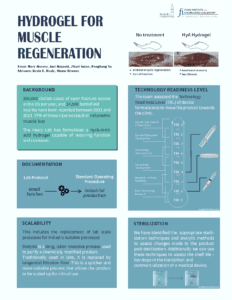 VML, an injury associated with the loss of significant amount of muscle tissue, is most commonly observed from extremity trauma injuries, which accounts for over 50% of all trauma injuries in military and civilian cases. Currently, there are no treatments that can fully recover a patient diagnosed with VML, making it impossible for patients to recover their normal complex movements. Our team is supporting research directed towards a successful FDA pre-IDE submission program to bring this therapeutic solution closer to clinical trials and commercialization. To translate this treatment from benchtop to industrial setting, our team is: identifying the most effective form factor (injectable hydrogel, lyophilized sponge and microspheres) for manufacturing, creating SOPs to scale cGMP manufacturing, and evaluating the effect of the anticoagulant.
VML, an injury associated with the loss of significant amount of muscle tissue, is most commonly observed from extremity trauma injuries, which accounts for over 50% of all trauma injuries in military and civilian cases. Currently, there are no treatments that can fully recover a patient diagnosed with VML, making it impossible for patients to recover their normal complex movements. Our team is supporting research directed towards a successful FDA pre-IDE submission program to bring this therapeutic solution closer to clinical trials and commercialization. To translate this treatment from benchtop to industrial setting, our team is: identifying the most effective form factor (injectable hydrogel, lyophilized sponge and microspheres) for manufacturing, creating SOPs to scale cGMP manufacturing, and evaluating the effect of the anticoagulant.
Team: Dennis Zhang [BIOE], Nanxi Li [IEOR], Siyuan Ren [IEOR], Tanaya Mangle [IEOR], Arun Putcha [IEOR], Heqing Huang [IEOR], Xiaolin Zhong [ME], Daniel Daugherty [ME], Robert Gadams [ME]
Advisor(s): Coleman Fung [Blue Goji], Austin Peck [BIOE], Gabriel Gomes [ME]
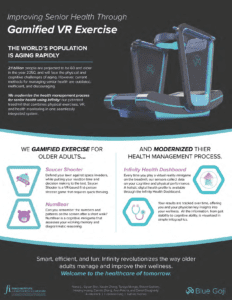 As the world population ages at an alarming speed, older adults are at risk for significant physical and cognitive challenges. The Blue Goji Infinity project aims to improve the health and well-being of older adults through a collection of gamified Virtual Reality exercises on its patented treadmill. Our team designs these VR mini-games, which track our users’ health performance to build digital health profiles. With this novel framework, we will revolutionize the way older adults manage and improve their wellness.
As the world population ages at an alarming speed, older adults are at risk for significant physical and cognitive challenges. The Blue Goji Infinity project aims to improve the health and well-being of older adults through a collection of gamified Virtual Reality exercises on its patented treadmill. Our team designs these VR mini-games, which track our users’ health performance to build digital health profiles. With this novel framework, we will revolutionize the way older adults manage and improve their wellness.
Team: Brenden Brown [BIOE]
Advisor(s): Ali Javey [EECS], Hnin Nyein [MSE]
Sweat sensing can be a powerful tool for obtaining biological measurements and information about a person’s health. However, only nanoliters to microliters of sweat are feasibly available for measurement over a reasonable period of time. Microfluidic devices can be used to collect such measurements, but their design must be carefully tuned (especially their channel dimensions) in order to function and get usable data. Using COMSOL computational fluid dynamics (CFD), these important sweat sensing microfluidic device dimensions can be optimized to work with realistic sweat rates.
Team: George Durrant [BIOE], Elie Celnikier [BIOE], Rongbo Zhou [ME]
Advisor(s): Pierre Karashchuk [Evolution Devices], Aashyk Mohaiteen [Evolution Devices], Gabriel Gomes [ME]
Neurological damage such as stroke, multiple sclerosis, and spinal cord injury cause walking impairments. The EvoCode team is improving the EvoWalk, a medical device developed by Evolution Devices, which corrects abnormal gait patterns of patients by electrically stimulating lower-limb muscles. The team aims to use machine learning techniques such as clustering and neural networks to allow the EvoWalk to analyze the kinematics of patients’ gait patterns. Then the device determines each individual’s gait pattern, and provides a personalized stimulation algorithm that most efficiently improves their walking outcome.
Team: Mudit Aggarwal [ME], Todd Roberts [ME], Leo Tao [ME], Daniel Wang [ME], Aiden Wolfe [ME]
Advisor(s): Homayoon Kazerooni [ME]
Team: Nikhil Gupta [MSE], Xinxun Zhu [MSE], Nien-Chen Weng [BIOE]
Advisor(s): Ben Fellows [BIOE], Steve Conolly [BIOE]
Over 400 million diabetic patients need to frequently check their blood sugar levels to avoid health complications. However, current glucose meters suffer from issues with patient compliance, invasiveness, biofouling, and cost. For this purpose, we are developing an implantable micro-scale magnetochemical sensor consisting of magnetic nanoparticles suspended in a glucose sensitive fluid. As glucose levels fluctuate, the viscosity of the implant shifts, and resulting changes in the nanoparticle dynamics can be related to glucose concentrations with a wearable magnetic relaxometer device. This biocompatible continuous glucose monitor will give diabetic patients a painless and affordable way to monitor their health.
Team: Benjamin Chen [BIOE], Shikhar Dhingra [BIOE]
Advisor(s): Gabriel Gomes [ME]
The market for exercise machines has grown dramatically in recent years due to a greater interest in fitness. To maximize the efficiency of workouts utilizing exercise equipment, we are developing a background technology capable of measuring one’s physical condition and fatigue level. This technology incorporates biosensors that collect the physiological parameters of a user to assess their current physical condition. This data is then run through our algorithm to assess fatigue levels for a variety of users. Overall, this innovation will allow workouts to be adjusted based on the user’s health history and their current state of fatigue.
Team: Kian Talaei [IEOR], Ryan Zolyomi [ME], Fang-Jhen Su [BIOE], Tianyi Xing [IEOR]
Advisor(s): Scott Lee [UC Berkeley School of Public Health], Taiki Nishihara [Ocuelar], Tarek Zohdi [ME]
More than 75 million people worldwide suffer from glaucoma–the leading cause of irreversible blindness. The majority of these patients lack a proper and consistent medication routine, a concept referred to as poor medication adherence. The team is developing a smart device to track patients’ eye drop medication adherence. Our smart eye drop bottle incorporates multiple on-board sensors paired with an algorithm to actively monitor timing of medication administration. The data is collected via an integrated patient-physician smartphone application. Accurate tracking of medication adherence will improve physician treatment decisions and patient quality of life.
Team: Anna Jiang [ME], Stephen Lan [BIOE], Zack Hsu [ME]
Advisor(s): Liwei Lin [ME], Ruiqi Guo [ME]
Traditional Chinese Medicine (TCM) is a branch of medicine with over 2000 years of history and success. With a device that uses TCM, we will be able to enable doctors and patients to detect cardiovascular diseases early on. By combining simple piezoelectric principles with a Wi-Fi enabled micro-controller, the pulse can be easily detected and characterized for a variety of diseases.
Team: Kaan Ardic [ME], Sahm Bazargan [ME], Chikeng Dong [ME], Matthew Kanter [ME], Aliya Kassam [ME], Qiaosong Liu [ME], Chenyu Shi [ME], Trent Storm [ME], Tiffany Tao [ME], Haobo Wang [ME]
Advisor(s): Coleman Fung [Blue Goji], Gabriel Gomes [ME]
What if it was possible to make exercise so enjoyable that people actually preferred working out to regularly playing video games? At first glance, this may not seem feasible given that Americans find more enjoyment in gaming (6 hours/week gaming) than they do exercising (2 hours/week exercising). However, Blue Goji – Team Velocity is looking to reimagine exercise by reinventing the stationary bike, making it a more engaging, enjoyable, and time-efficient experience. Through the implementation of VR gaming and a tether support system that helps to physically immerse the user, we are giving riders a unique way to simultaneously game while burning more calories in less time.
Team: Ross Schneider [ME], Anisha Basu [BIOE], Hayley Boyd [BIOE]
Advisor(s): Juan Rodriguez [Evolution Devices], Andrew Ekelem [Evolution Devices], Gabriel Gomes [ME]
![]() A third of people over the age of 60 suffer from impaired gait, which leads to loss of personal freedom, falls, and injuries. Falls are the leading cause of fatal injury and trauma-related hospital admission among older adults, and costs around $50 billion each year. We are developing an affordable, user-friendly system that provides physician-requested gait metrics for aiding in the diagnosis of unhealthy walking patterns. Our system consists of wearable units that are comfortably strapped to the user, which along with modern software filtering techniques and real-time embedded programming solutions allows a constant stream of motion tracking data.
A third of people over the age of 60 suffer from impaired gait, which leads to loss of personal freedom, falls, and injuries. Falls are the leading cause of fatal injury and trauma-related hospital admission among older adults, and costs around $50 billion each year. We are developing an affordable, user-friendly system that provides physician-requested gait metrics for aiding in the diagnosis of unhealthy walking patterns. Our system consists of wearable units that are comfortably strapped to the user, which along with modern software filtering techniques and real-time embedded programming solutions allows a constant stream of motion tracking data.
Machine Learning: Applications for Entrepreneurship, Strategy, and Operations
Team: Sophie Pealat [IEOR], Miguel Fernandez-Montes [IEOR], Pierre Lucas [IEOR]
Advisor(s): Karoline Skatteboe [Spacemaker.ai], Gabriel Gomes [ME]
As the world population concentrates in cities, urban design becomes a crucial, although time-consuming and subjective, process. The Spacemaker AI team proposes a series of data-driven feature extraction procedures to objectively and efficiently describe outdoor spaces in urban sites. To this end, concepts from graph-theory and general geometric analysis have been implemented on layout data from Spacemaker’s API.
Team: Joshua Edwards [IEOR], Chuqing Qin [IEOR], Fengbin Wang [IEOR], Qing Wen [IEOR], Shih-Cheng Lu [ME]
Advisor(s): Lorenzo Einaudi [Tenaris] & Adonis Ichim [Tenaris], Matt Sherburne [MSE]
Oil & Gas companies make a great effort in locating the most economical and profitable wellbore sites across the world. This is done in part to minimize additional extraneous costs and prevent against environmental damage. Our team is developing significant evaluation criteria to classify the quality of wellbores in a distinct location. The classification model is generated using machine learning algorithms, trying to determine the minimal number of factors that best represent the quality of wellbores and classify numerous scenarios.
Team: Irem Bagdatli [IEOR], Nina He [IEOR], Owen Liu [IEOR], Wenjing Lu [IEOR], Yuchen Zheng [ME]
Advisor(s): Zuo-Jun Max Shen [IEOR], Cristobal Pais Martinez [IEOR], Titouan Jehl [IEOR]
An eCommerce platform bears high risk of consumer dissatisfaction when understock and extra costs in supply chain when overstock to introduce new products without demand forecasting tools. Our team aims to predict the demand for new products for the future date based on vendor, delivery center, shopper purchase history, and inventory source type. Using products data from JD.com, we are building a system to help eCommerce platforms better understand the new products aspects, and achieve an accurate demand forecasting in order to minimize supply chain cost, and promote more sales.
Team: Ethan Stobbe [ME], Johnson Kanjirathinkal [IEOR], Huoran Yuan [BIOE], and Xiaoxi Cui [CEE]
Advisor(s): Lee Fleming [IEOR]
Laboratories funded by the US Government are granted over 700 patents each year, yet fewer than half of these technological developments will ever get integrated into our economy. Of the many ways this problem can be addressed, one of the most promising is a growing number of partnerships between National Laboratories and other institutions. Our UC Berkeley team is working with Lawrence Berkeley National Laboratory (LBNL) to develop a licensing strategy for an advanced laser measurement (LiDAR) patent. We are uniquely leveraging a state-of-the-art virtual reality (VR) tool, UC Berkeley alumni connections, and the lab’s proximity to Silicon Valley to create a comprehensive commercialization recommendation for LBNL.
Team: Junlei Li [IEOR], Hao Cui [IEOR], Peihao Jiang [IEOR]
Advisor(s): Zuo-Jun Max Shen [IEOR], Meng Qi [IEOR], Titouan Jehl [IEOR], Cristobal Pais [IEOR]
Vendor lead time is the time between placing an order and receiving goods that is important for buyers and retailers to make selling or purchasing decisions. It varies rapidly during holiday seasons and special events (Black Friday). Our group applied machine learning knowledge to find correlated factors for predicting VLT. In order to help an e-commerce platform stabilize purchasing models and reduce inventory cost.
Team: Xiaohan Wang [IEOR], Shengjie Bian [IEOR], Yuandong Xu [IEOR], Muxuan Yu [IEOR], Haojun Huang [IEOR]
Advisor(s): Zuo-Jun Max Shen [IEOR], Cristobal Pais Martinez [IEOR], Titouan Jehl [IEOR]
As the largest online retailer in China with millions of data, JD.com is eagerly searching for data-driven methodologies to understand customers, so as to set up and upgrade their product supply strategies. One of the challenges that JD.com is facing now is to use historical data of sales information and attributes information of old products, to predict sales of new product by only using their attributes information as inputs. Our objective is to provide them with a systematic machine learning solution which maximizes prediction accuracy to tackle such problem.
Team: Senthil Kumar Venkatachalam [IEOR], Gauri Nirmalchandra Parkar [ME]
Advisor(s): Alice Agogino [ME], Vivek Rao [ME]
Designing a secure and immersive environment without compromising user experience is a serious challenge to the widespread adoption of the virtual reality technology. The framework that we developed aims at protecting the Virtual Reality users by monitoring cyber vulnerabilities. It proactively alerts product designers for potential threats thereby reducing cyber risks and enhancing user experience.
Team: Chang Li [EECS], Ao Liang [EECS], Nishita Shetty [EECS], Jason Xu [EECS], Cassie Zhang [EECS], Jingran Zhou [EECS]
Advisor(s): Kurt Keutzer [EECS], Rob Rodick [EECS], Ravi Krishna [EECS]
Team: Cinyi Mao [IEOR], Demi Ibrahim [BIOE], Elsa Wang [IEOR], Jessica Chow [NE], Remi Luyssaert [IEOR]
Advisor(s): Lee Fleming [IEOR]
The semiconductor and nuclear medicine industries face technological and financial barriers with accelerator technology. Traditional linear accelerators used are bulky, big enough to fill a room, and take days to repair when they breakdown. Innovation in these fields is crucial to develop cheaper and accessible technology for hardware and cancer treatments. Modular ion accelerators could disrupt semiconductor material diagnostics and cancer therapy treatment thanks to their low cost, easy maintenance, and compact size. Our team is mapping a go-to-market strategy for a patented wafer-based particle accelerator created in collaboration by inventors from Lawrence Berkeley National Lab and Cornell University.
Team: Hanqing Xie [IEOR], Tianyuan Cao [IEOR], Wanying Fang [IEOR], Kavya Ravali [IEOR], Maria Jesus Perez [IEOR]
Advisor(s): Lee Fleming [IEOR]
Top 1000 companies in the US have spent more than $300 billion on R&D in 2018, but 97% percent of inventions never make any money. The tech team builds an automated data analysis system to predict popularity across different technology categories. We use feature engineering to extract features from raw data, machine learning to model the features, and virtual reality to visualize the prediction. This will help companies to make IP strategy more efficient.
Team: Jingxi Huang [EECS], Ziqian Qin [EECS], Axel Chauvin [EECS], Faye Yu [EECS]
Advisor(s): Houston Putman [Bloomberg], Densel Santhmayor [Bloomberg], Ken Laporte [Bloomberg], Vladimir Marko [EECS]
Apache Solr is an open-source search engine that owns 30.98% of the enterprise search market but lacks a user notification system. Team Bloom-Berkeley-Solr is collaborating with Bloomberg to build a distributed user notification platform. It enables Solr to constantly monitor any updates in the database and notify users in real-time. We extend the stream processing language in Solr and take advantage of a stored query engine to build the platform. The robust platform allows users to stay up-to-date on any subject of interest in their database system.
Team: Jocselyn Qiu Qiu [IEOR], Yangyiying Pu [IEOR], Yue Yu [IEOR], Xiaoyan Wang [IEOR], Yichen Bei [IEOR], Ilias Miraoui [IEOR], Chengwu Shen [IEOR]
Advisor(s): Damien Thioulouse [Asurion], Clement Ruin [Asurion]
Worried about how costly and time-consuming it is to respond to your customers? Market research argues that it takes more than 12 hours and costs at least $15 to respond to each customer service ticket. Leveraging data science techniques, our team alleviates this concern by building a system that provides better insights into customer inquiries and accelerates an expert’s response time. Using natural language processing models, we help agents by providing summarized customer intentions and automatically completing their sentences so they can respond faster and be more helpful to their clients’ pressing issues.
Team: George Hertlein [IEOR], Leonardo Huerta [ME], Bailing Zhan [IEOR]
Advisor(s): Kosa Goucher-Lambert [ME]
 Product designers spend a vast amount of time and effort brainstorming and searching for inspiration. Our team is creating a data-driven tool that provides real-time content related to the user’s text and sketch input. We are using natural language processing and computer vision to identify the user’s input in a semantic level and deliver inspirational stimuli from an image database.
Product designers spend a vast amount of time and effort brainstorming and searching for inspiration. Our team is creating a data-driven tool that provides real-time content related to the user’s text and sketch input. We are using natural language processing and computer vision to identify the user’s input in a semantic level and deliver inspirational stimuli from an image database.
Team: Tianyue Chen [IEOR], Sissy Deng [IEOR], Daniel Chung [IEOR], Eric Robbins [IEOR], Changjin Liu [IEOR], Aditya Peshin [IEOR]
Advisor(s): Jennifer Prendki [Alectio], Gabriel Gomes [ME]
Our team experiments with a smarter data selection approach called Active Learning by using metadata to optimize the learning approach of the model. The outcome enables the training of ML models with up to 60% reduction in data consumption, shorter training times, and lesser annotation costs while preserving or improving model accuracy.
Team: Peng Gu [EECS], Purva Gupta [EECS], Zhuoyue Wang [EECS], Zetian Xiao [EECS], Sikai Yin [EECS]
Advisor(s): Bjoern Hartmann [EECS], Eldon Schoop [EECS]
Makerspaces at UC Berkeley collect a lot of data and staff desire to have a tool that would help them understand data present and facilitate decision making. Our team’s aim is to build a real-time analytics dashboard for makerspaces on campus to help staff plan for the space such as busy times of the semester, equipment usage, reservation management and overall to improve the student experience. The dashboard collects varied types of data from different data sources in makerspaces such as equipment data or badge-ins and visualizes trends using Python graphing libraries.
Team: Joanne Jiang [IEOR], Jiazhou Chen [IEOR], Sol Eun [IEOR], Hao (Howard) Zheng [IEOR], Neelabh Mishra [IEOR]
Advisor(s): Paul Grigas [IEOR]
Over 70% of Google and Facebook’s total revenue comes from online advertising, which relies heavily on user data collected through their free services. Conventional advertising algorithms over-utilize sensitive data and may cause issues regarding customer privacy. It is a major interest for these technology companies to find a way to comply with the regulations while maintaining their advertising performance. Using the latest research in this area, we aim to prove that it is possible to generate a model for achieving a balance between business interests and social good.
Team: Sebastien Laplane [IEOR], Xiayu Cai [IEOR], Hao Wang [IEOR], Hao Zhang [IEOR], Yongming Zhu [IEOR]
Advisor(s): Zuo-Jun Max Shen [IEOR], Cristobal Pais Martinez [IEOR], Titouan Jehl [IEOR]
For a company operating an online retail platform, supply chain management is critical. A remarkable metric for supply chain management is given by the vendor lead time, which measures the time spent from when a purchase order is placed to the time that the inventory is ready for delivery. We are developing a machine learning model predicting the vendor lead time, trained on the historical sales dataset via Python, which allows the e-retailer to anticipate the shortage of inventories and delay of deliveries, and ultimately optimize the supply chain management. Our project is authorized by JD.com, an e-commerce company from China, and we worked closely with JD’s representatives to enhance the model.
On the Move: Autonomous, Electrical, Aerial, Underwater Vehicles
Team: Dingyi Dong [CEE], Venkat Raju Punyaamurthula [IEOR], Suhas Bommenahally Umesh [IEOR]
Advisor(s): Jasenka Rakas [CEE]
Lightning often damages critical aviation infrastructure, such as Air Traffic Control Tower. However, budget constraints restrict the feasibility of lightning fortification at all airports. Our study will quantify the vulnerability of critical infrastructure systems to failures due to convective weather (such as lighting strikes) and the effect of such failures on delays and cancellations. Identifying the most affected airports can help in making smart decisions on investment in infrastructure. Our study uses manipulation of vast amounts of FAA data and network analysis to recommend a lightning fortification action plan to the FAA, and will help to reduce delay and cancellation of Airlines.
Team: Di Chen [CEE], Hanrui Cui [CEE], Yipeng Zhang [CEE], Lingjie Li [CEE], Zhexu Wu [ME], Zheng Liu [ME]
Advisor(s): Alexander Skabardonis [CEE], Soomin Woo [CEE], Mingyuan Yang [CEE]
As the traffic demand increases, there are more interests on how the mobility will be improved and if it is worthy of adopting the Connected and Automated Vehicles (CAVs) into reality. This project investigates the potential impacts of CAVs on the improvement of mobility in transportation networks at arterial signalized roads and freeways. Our team adjusts market penetration rates of CAVs and traffic demand factors in Aimsun. We locate bottleneck in freeways to measure and analyze road capacities and its changes. We use Autonomie to simulate vehicle trajectories in arterial roads and analyze their emission reductions.
Team: Ross Alexander [ME], Long Teng [ME], Suiyi He [ME], Yucheng Zhang [ME]
Advisor(s): Koushil Sreenath [ME], Prasanth Kotaru [ME]
The commercial drone market is forecasted to reach 13 billion by the end of 2020, delivering services such as wildfire surveillance, package delivery and airborne inspections. The autonomous racing team strives to improve drone performance by building an autonomous racing drone that can contend with and beat human pilots. By adding an onboard computer and a depth camera to a first-person view racing drone, our platform can map out a racetrack and follow a pre-computed optimum trajectory. To improve lap times, we replaced the traditional jerk-minimization trajectory generation approach with learning-based model predictive control, which uses historical data from past races to improve system performance.
Team: Kristen Biermayer [ME], Ed Izaguirre [ME], Derek Lau [ME], Scott Gilroy [ME]
Advisor(s): Koushil Sreenath [ME], Ayush Agrawal [ME]
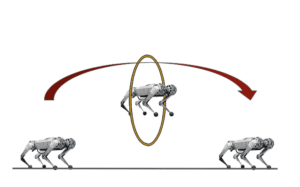 In recent years, the development of quadruped robots has opened up opportunities for novel dynamic motions. We are using the MIT Mini Cheetah as a research platform for the development of quadruped robot control. The goal of our research is to make the MIT Mini Cheetah jump through a hoop. To achieve this motion, we use trajectory optimization, computer vision and joint control. By making the cheetah jump through the hoop, we are making advancements in robotics research that will be built upon in future research.
In recent years, the development of quadruped robots has opened up opportunities for novel dynamic motions. We are using the MIT Mini Cheetah as a research platform for the development of quadruped robot control. The goal of our research is to make the MIT Mini Cheetah jump through a hoop. To achieve this motion, we use trajectory optimization, computer vision and joint control. By making the cheetah jump through the hoop, we are making advancements in robotics research that will be built upon in future research.
Team: Chenming Cui [ME], Tianxiang Zhu [ME], Yu-Ting Tsai [ME], Shikhar Sharma [ME]
Advisor(s): Gabriel Gomes [ME]
We are living in an era driven by Artificial Intelligence. AI is able to add intelligence and analyse deeper data with incredible accuracy. The goal of our project is to use Reinforcement Learning as a tool to enable our agent to make optimal decisions in an unknown environment. We plan to achieve this by applying the concept of ‘positive and negative rewards’ which the agent will receive over a period of time and train itself to maximise its cumulative reward. This method has a scalable real world application in multiple sectors where autonomous transportation plays a key role in creating strategic value across the supply chain. Additionally, the agent can be trained for disaster response and subsequent transmission of critical information by navigating in hazardous environments, paving way for safe action by response teams.
Team: Manish Ravi [ME], Antoine Jamme [ME]
Advisor(s): Gabriel Gomes [ME]
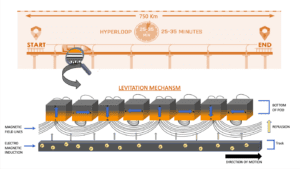 Nowadays, traveling long distances either requires a lot of time or a lot of fuel consumed which is a big threat to the environment. Today, 40% of pollution worldwide is directly or indirectly due to transportation. Imagine being able to travel as fast as a plane and cleaner than a motorcycle. That’s what Hyperloop is all about: A levitating train moving at ultrasonic speeds in a vacuum tube using electromagnetism. Our team is working on a crucial aspect of this train, the levitation system. Our prototype demonstrates the feasibility of a passive levitation system that relies on Halbach arrays of permanent magnets at the bottom of the train which creates lift when at motion on top of a conductive material without any input of external energy.Yanis Pradeau [CEE]
Nowadays, traveling long distances either requires a lot of time or a lot of fuel consumed which is a big threat to the environment. Today, 40% of pollution worldwide is directly or indirectly due to transportation. Imagine being able to travel as fast as a plane and cleaner than a motorcycle. That’s what Hyperloop is all about: A levitating train moving at ultrasonic speeds in a vacuum tube using electromagnetism. Our team is working on a crucial aspect of this train, the levitation system. Our prototype demonstrates the feasibility of a passive levitation system that relies on Halbach arrays of permanent magnets at the bottom of the train which creates lift when at motion on top of a conductive material without any input of external energy.Yanis Pradeau [CEE]
Advisor(s): Gabriel Gomes [ME]
Team: Jessica Elder [NE], Mark Ma [MSE], Shubham Mandot [NE]
Advisor(s): Kai Vetter [NE], Ali Hanks [NE], Michael Bondin [NE]
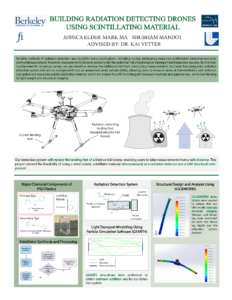 Reliable methods of radiation detection are crucial for many applications, ranging from nuclear accident measurement to covert nuclear facility detection. Our team aims to build a radiation detection system to be incorporated into a drone. Our system will use custom-grown and shaped plastic scintillator material, which will enable the device to be light-weight and to distinguish between neutrons and gamma-rays.
Reliable methods of radiation detection are crucial for many applications, ranging from nuclear accident measurement to covert nuclear facility detection. Our team aims to build a radiation detection system to be incorporated into a drone. Our system will use custom-grown and shaped plastic scintillator material, which will enable the device to be light-weight and to distinguish between neutrons and gamma-rays.
Team: David Scanlan [IEOR], Pierre-Louis Blossier [ME], Johan Gerfaux [IEOR], Bowen Wang [ME]
Advisor(s): Jimmy Wang [Zendar], Lou Ggraniou [Zendar], Gabriel Gomes [ME]
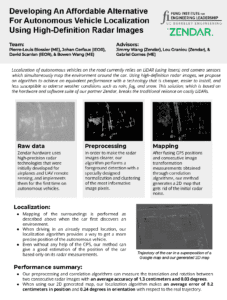 Localization of autonomous vehicles on the road currently relies on LIDAR (using lasers) and camera sensors which simultaneously map the environment around the car. Our algorithm uses high definition radar images to localize autonomous vehicles. In combination with Zendar’s hardware and software suite, this solution is cheaper, easier to install, and less susceptible to adverse weather conditions when compared to costly LIDARs.
Localization of autonomous vehicles on the road currently relies on LIDAR (using lasers) and camera sensors which simultaneously map the environment around the car. Our algorithm uses high definition radar images to localize autonomous vehicles. In combination with Zendar’s hardware and software suite, this solution is cheaper, easier to install, and less susceptible to adverse weather conditions when compared to costly LIDARs.
Team: Bohan Jiang [ME], Yuxuan Li [ME], Yi Shen [CEE], Binqi Zhao [IEOR]
Advisor(s): Nathaniel Michaluk [GM], Ghiwa Lamah [GM], Gabriel Gomes [ME]
US electric vehicle sales increased by 81% from 2017 to 2018. However, 58% of drivers who are unlikely to purchase an electric vehicle are influenced by factors like range anxiety. The General Motors team is developing a simulated electric vehicle test drive app that will help eliminate skepticism by providing a first-hand experience of what life would be like with an electric vehicle. The application will model a virtual electric vehicle, feed the operating conditions of the host vehicle into the model, and report the status of the emulated vehicle through the in-vehicle application user interface.
Team: Patrick Savage [CEE], Qilei Zhang [CEE]
Advisor(s): Jasenka Rakas [CEE]
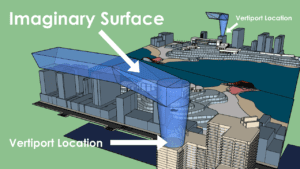 Due to increasing congestion in urban areas, there is a high demand for a new form of safe and environmentally-friendly transportation. A new type of air vehicles, electric vertical takeoff and landing (eVTOL) vehicles, are proposed to fly in urban areas to help urban dwellers travel faster. However, there are many uncertainties about this new mode of transportation because rules and regulations have not yet been determined. Our proposed solution will provide a set of flight standards for creating imaginary surfaces that guide the takeoff and landing of eVTOL vehicles in urban settings. These surfaces are designed to help aircraft avoid collision with infrastructure obstacles and minimize their noise impact.
Due to increasing congestion in urban areas, there is a high demand for a new form of safe and environmentally-friendly transportation. A new type of air vehicles, electric vertical takeoff and landing (eVTOL) vehicles, are proposed to fly in urban areas to help urban dwellers travel faster. However, there are many uncertainties about this new mode of transportation because rules and regulations have not yet been determined. Our proposed solution will provide a set of flight standards for creating imaginary surfaces that guide the takeoff and landing of eVTOL vehicles in urban settings. These surfaces are designed to help aircraft avoid collision with infrastructure obstacles and minimize their noise impact.
Team: Mozheng (Edward) Hu [ME]
Advisor(s): Gabriel Gomes [ME]
For the upcoming 2021 Formula SAE EV California Competition, teams from all over the world will compete with each other using their self-completed electric formula-style racing vehicles. The UC Berkeley EV team aims to successfully and safely complete all the challenges included in the competition using a self-made EV from scratch. Our team will design and build a reliable and functional hydraulic braking system for the success of the UC Berkeley EV team.
Team: Chi Zhang [ME], Sumanyu Singh [ME], Shakshi Himmatramka [ME]
Advisor(s): Jeffrey Pieper [GM], Gabriel Gomes [ME]
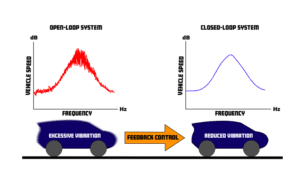 On average, American people spend an hour daily in their cars. The undamped vehicle vibrations can have undesirable physical effects on humans. Additionally, Vibrations can cause accelerated fatigue (and in some worst-case scenarios, immediate failure!) to the mechanical components. The vibrations in the longitudinal direction of motion are prone to resonances exhibited by the components of the driveline. These vibrations can be controlled by modifying the motor torque using feedback control. This project includes exploring how some of the established control strategies could be employed to provide a robust system damping in an automotive application using a representative simulation environment.
On average, American people spend an hour daily in their cars. The undamped vehicle vibrations can have undesirable physical effects on humans. Additionally, Vibrations can cause accelerated fatigue (and in some worst-case scenarios, immediate failure!) to the mechanical components. The vibrations in the longitudinal direction of motion are prone to resonances exhibited by the components of the driveline. These vibrations can be controlled by modifying the motor torque using feedback control. This project includes exploring how some of the established control strategies could be employed to provide a robust system damping in an automotive application using a representative simulation environment.
Team: Shuli Yang [EECS], Mengze Zhu [EECS], Yanda Li [EECS], Jinheng Xu [EECS], Zixuan Yang [EECS], Xuan Su [EECS]
Advisor(s): Alexandre Bayen [EECS], Theophile Cabannes [EECS]
There is a significant imbalance between jobs and housing in Silicon Valley, resulting in disruptive congestion in Fremont, as employees commute through. The main goal of the project is to mitigate the cut-through traffic in Fremont. We model the current situation to identify main causes of congestion. We use data from Fremont and Google APIs. We use Python for data processing, ArcGIS for data visualization and Aimsun for traffic simulation. We aim to adjust the simulation parameters to mitigate congestion and lessen cut-through traffic. Traffic calming measures are suggested such as adjusting traffic signal light plans and imposing turn restrictions.
Team: Xiyu Zhai [EECS], Yichen Zhou [EECS], Lu Yu [EECS], Zoey Cao [EECS], Changxu Zhang [EECS]
Advisor(s): Alexandre Bayen [EECS], Fangyu Wu [EECS]
Current traffic is always jammed because of the behavior of each driver. If we can design a set of behavior based on traffic algorithms to guide each driver in a way based on optimizing the whole traffic flow, the transportation jam can be mitigated. In our project, we deployed self-driving algorithms on robotic vehicles to simulate traffic flow and developed a framework to provide all the APIs like Computer Vision, Control Algorithms. We managed the traffic flow of twenty cars running on the same map with an advanced control strategy more efficiently than simulating human drivers.
Team: Rajarathnam Balakrishnan [IEOR], Xueqi Zhao [IEOR], Xinyue Liu [IEOR], Tianrui Huang [IEOR]
Advisor(s): Anil Aswani [IEOR]
Autonomous vehicles are set to be the future of transportation with many reported developments in autonomous driving systems. The need to process various sensory inputs for such systems from vehicle integrated cameras, radars and other sensors for further control and maneuver is tremendous. Team AutoDrive Vision is using a combination of Convolutional Neural Networks and other Deep Learning methods to build an image recognition algorithm capable of detecting pedestrians and vehicles for ego-vehicle. The outputs of this algorithm would enhance the perception field of ego-vehicle by increasing the accuracy of the autonomous driving system.
Team: Siyi Zhang [IEOR], Sharnam Shah [ME], Elise Perez y Landazuri [ME]
Advisor(s): Chantal Emmanuel [Limeloop], Ashley Etling [Limeloop], George Anwar [ME]
We are creating the very first intelligently reusable e-commerce packages by developing an IoT solution using sensors and a cloud platform. Specifically, the goal of our project is to prototype an IoT solution with open rate tracking, data transmission and cloud service.
Team: Jonathan Kestelman [CEE], Pedro Errazuriz [IOER], Sihan Liu [IEOR], Yan Xiao [IEOR]
Advisor(s): Scott Moura [CEE]
The implementation of electric vehicles in the transportation world has not been followed by the development of an infrastructure that can support the increased demand for electricity. In addition, the developed charging stations are poorly managed, allowing users to occupy spots even when the vehicles are not charging. Smart Electric Vehicle Charging Stations (SEVCS) approach is to allow the users to decide how they want their charging service to be delivered and manage this demand focusing on reducing the impact on the electric grid and reducing operational costs for owners. By creating pricing and charging algorithms with the implementation of machine learning and data analytics, SEVCS is able to induce certain human behavior in order to optimize the idle time and the maximum power of the station as a whole.
Team: Ann Chia [MSE], Anthony Yan [ME], Eric Stern [ME], Liam Doran [ME]
Advisor(s): Reza Alam [ME], Alexandre Immas [ME]
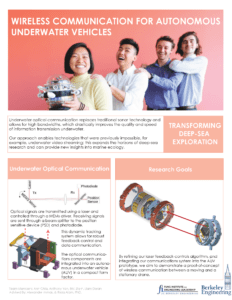 With current technology, even planets that are light years away had been mapped out with higher resolution than most of the seafloor on Earth. Limited by low bandwidth underwater communication, sonar is the traditional approach for underwater communication. Our team aims to use optical communication to create low cost, high bandwidth means of underwater networking between swarms of Unmanned Underwater Vehicles (UUV) for wireless communication. By modulating lasers at high frequencies, and through advanced control methods, we aim to transmit data across large stretches of open ocean at vastly faster speeds than traditional methods. Specifically, our group has been building onto our research lab’s existing UUVs to design, build, and integrate a wireless means of communicating through lasers in open ocean environments.
With current technology, even planets that are light years away had been mapped out with higher resolution than most of the seafloor on Earth. Limited by low bandwidth underwater communication, sonar is the traditional approach for underwater communication. Our team aims to use optical communication to create low cost, high bandwidth means of underwater networking between swarms of Unmanned Underwater Vehicles (UUV) for wireless communication. By modulating lasers at high frequencies, and through advanced control methods, we aim to transmit data across large stretches of open ocean at vastly faster speeds than traditional methods. Specifically, our group has been building onto our research lab’s existing UUVs to design, build, and integrate a wireless means of communicating through lasers in open ocean environments.
Team: Guanqun Huang [ME], Mingguang Zhou [ME], Muireann Spain [ME], Nathan Srinivasan [ME], Wei Hu [ME]
Advisor(s): Francesco Borrelli [ME], Xu Shen [ME]
Reducing the amount of human error with repetitive tasks that may involve heavy loads can allow an improvement in operating efficiency and human safety, since humans are prone to injury and are required to work for a certain number of hours at a time. Our team is developing a universal platform that will be able to navigate through a pre-planned route autonomously while carrying a heavy load.
Team: Elsie Wang [IEOR], Laetitia Moine [CEE], Fellipe Marcellino [IEOR]
Advisor(s): Gabriel Gomes [ME]
People spend between 100 hours to 200 hours in traffic each year in big cities, which has a negative impact on daily life due to productivity loss, air pollution and stress. Our team is optimizing traffic lights in road intersections to reduce congestion and time spent in traffic, therefore improving the overall efficiency of the system. Our solution includes a traffic model which enables us to simulate the flow of vehicles on roads and in intersections.Within this model, we use Reinforcement Learning to find optimal strategies to control traffic lights.
Team: Yuet Man Kan [CE], Tanat Vanichpipat [CE], Evan Christianson [CE], Pei-Wen Hu [CE], Eindra Aung [CE], Sushmitha Sree Gumireddy [CE], Cong Luo [CE]
Advisor(s): Alexander Skabardonis [CE]
Commuters everywhere experience frustration and delays due to traffic congestion. Dense urban areas such as San Francisco create the largest problems. The general solution is to expand infrastructure but this is expensive, time-consuming, and politically complicated. Instead, our team will reduce delays by optimizing traffic signal sequences with sophisticated simulations of the street traffic conditions .With better traffic control we can provide an inexpensive and easily implemented relief to commuters.
Team: Léo Toulet [EECS], Robert Zangnan Yu [EECS], Anyi Chen [EECS], Xinyi Tang [EECS]
Advisor(s): Alexandre Bayen [EECS], Jessica Lazarus [ITS]
The average person spends more than an hour sitting in traffic every day in San Francisco. This has a huge impact on public health, economic productivity, and pollution; in a world where both qualities of life and environmental concerns are at the forefront of public debate. We are using cutting edge machine learning technology to build an open-source transportation-planning decision support system that will enable policymakers to make informed decisions about bridge tolls, public transportation schedules, and financial incentives; taking into account all involved stakeholders (such as citizens, elected officials, and the environment). This will allow transportation authorities to optimize traffic in a way that reduces pollution, delays and financial costs for daily commuters.
Visual Computing and Computer Graphics
Team: Roy Guo [EECS], Zixi Cai [EECS], Yitong Li [EECS]
Advisor(s): Allen Yang [EECS]
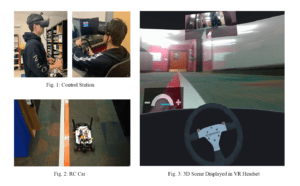 The recent development of VR technologies and the success of the movie, “Ready Player One”, have created a fast-emerging need for people to pursue a new form of racing game that is both immersive and mobile. Our vision is to create a reliable, portable, safe and user-friendly VR racing platform that is generic supporting various vehicles and robots. Our work aims to maximize immersiveness to enhance the driving experience. Leveraging the novel wifi technology and the efficient multi-media framework in the software aspect, as well as Arduino-Jetson communication in the hardware aspect, we achieve real-time control and jitter-free video feedback.
The recent development of VR technologies and the success of the movie, “Ready Player One”, have created a fast-emerging need for people to pursue a new form of racing game that is both immersive and mobile. Our vision is to create a reliable, portable, safe and user-friendly VR racing platform that is generic supporting various vehicles and robots. Our work aims to maximize immersiveness to enhance the driving experience. Leveraging the novel wifi technology and the efficient multi-media framework in the software aspect, as well as Arduino-Jetson communication in the hardware aspect, we achieve real-time control and jitter-free video feedback.
Team: Toby Baker [EECS], Ayusman Saha [EECS], Weihao Dong [EECS], Sean Lin [EECS], Fangping Shi [EECS]
Advisor(s): Brian Barsky [EECS]
According to the Occupational Safety and Health Administration (OSHA), almost 2 million U.S. workers suffer from Repetitive Strain Injuries (RSI) such as carpal tunnel syndrome or tendinitis. These impairments hinder an individual’s ability to use a traditional computer mouse. By utilizing a webcam, users will be able to manipulate a cursor at a low cost and without touching a physical device. This is achieved by employing computer vision techniques and machine learning algorithms. Key points of the hand are extracted from the image and used to generate a feature set to train a model to map gestures to cursor actions.
Team: Tarkan Al-Kazily [EECS], Wei-Chun Hwang [EECS], Eric Liu [EECS], Melody Mao [EECS], Chun-Ning Tsao [EECS]
Advisor(s): Brian Barsky [EECS]
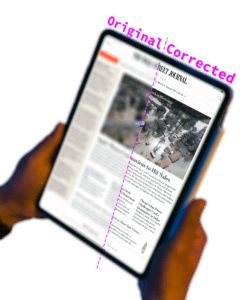 Optical defocus problems like nearsightedness and farsightedness affect the vision of millions worldwide, preventing them from reading displays without prescription lenses. A Vision Correcting Display (VCD) allows users to clearly see images without additional correction by changing the image according to the user’s prescription. Existing VCD algorithms are designed to correct general optical problems, making them inefficient and complex. We narrow our scope to only correct optical defocus by modularizing previous VCD research and utilizing raytracing and Gaussian optics models. As a result, our VCD algorithms have improved computational efficiency while still maintaining image quality.
Optical defocus problems like nearsightedness and farsightedness affect the vision of millions worldwide, preventing them from reading displays without prescription lenses. A Vision Correcting Display (VCD) allows users to clearly see images without additional correction by changing the image according to the user’s prescription. Existing VCD algorithms are designed to correct general optical problems, making them inefficient and complex. We narrow our scope to only correct optical defocus by modularizing previous VCD research and utilizing raytracing and Gaussian optics models. As a result, our VCD algorithms have improved computational efficiency while still maintaining image quality.
Team: Yizhen Ding [EECS], Sundi Xiao [EECS], Xiaoyu (Evelyn) Yang [EECS], Zhuoming Zhang [EECS], Yaying Zhao [EECS]
Advisor(s): Brian Barsky [EECS]
According to the World Health Organization, globally at least 2.2 billion people have vision impairments. Vision correcting display provides an alternative way for people with vision impairments to see a digital screen clearly, without any eye wears or undergoing surgeries. However, Vision Correcting Display algorithm requires the user to have a fixed viewing position. To eliminate the spatial limitations, our capstone project adjusts this technology to allow flexible user positions with computer graphics and ray-tracing techniques. We use retinal light field projection to compensate for the optical blurring. This project could become a transformative technology that has a profound impact on how we interact with digital devices.
Team: Hsin Pei Lee [EECS], Xi Chen [EECS], Gang Yao [EECS], Kewei Sui [EECS]
Advisor(s): Allen Yang [EECS]
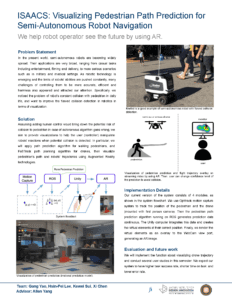 The industrial trend for autonomous robots is to develop ever more sophisticated self-navigation algorithms and systems as an endeavor to ultimately remove human control. However, most of the self-navigation systems today are not entirely reliable, meaning the possibilities of collision still stands despite the effort of object avoidance algorithms. We assume that under certain circumstances, introducing human control for autonomous systems could increase the level of safety and that semi-autonomous robot navigation would better fit into the current social context. Based on an implementation of a pedestrian path prediction algorithm, we developed an augmented reality system to visualize the prediction result as a visual cue for the robot operator to adjust robot navigation strategies accordingly.
The industrial trend for autonomous robots is to develop ever more sophisticated self-navigation algorithms and systems as an endeavor to ultimately remove human control. However, most of the self-navigation systems today are not entirely reliable, meaning the possibilities of collision still stands despite the effort of object avoidance algorithms. We assume that under certain circumstances, introducing human control for autonomous systems could increase the level of safety and that semi-autonomous robot navigation would better fit into the current social context. Based on an implementation of a pedestrian path prediction algorithm, we developed an augmented reality system to visualize the prediction result as a visual cue for the robot operator to adjust robot navigation strategies accordingly.
Team: Yohan Mysore Ramakrishna [EECS], Jiewen Lai [EECS], Qi Wu [EECS]
Advisor(s): Allen Yang [EECS]
With an estimated technology market of 8.23B by 2027, the secret ingredient that drives the future of the 3D technological world is SLAM. SLAM is a key algorithm in the AR/VR, Robotics and Self-Driving car industry that generates a 3D map while keeping track of the camera’s location. The OpenARK SLAM team is working on optimizing the widely used OKVIS SLAM algorithm by identifying and fixing the corner cases where it currently fails.
Team: Hugh Johnson [EECS], Li Yang Kat [EECS], Jesse Ku [EECS], Arjun Sabnis [EECS], Steven Sun [EECS], Jiaqi Zhang [EECS]
Advisor(s): Ren Ng [EECS]
Cells in the human retina have spectral sensitivities that prevent them from being individually stimulated by natural light. As a result, humans cannot perceive all possible colors. For the colorblind, this range is limited even further. The Oz Vision project is developing an adaptive optics system to stimulate individual cells in the eye. Our team upgraded the system software to project a wider field-of-view centered on the retinal focal point and include video playback capabilities, allowing a subject to freely gaze over the displayed stimulus. This will facilitate more immersive experiments that will push the boundaries of vision science and enable the perception of new colors, for normal and colorblind subjects alike.


